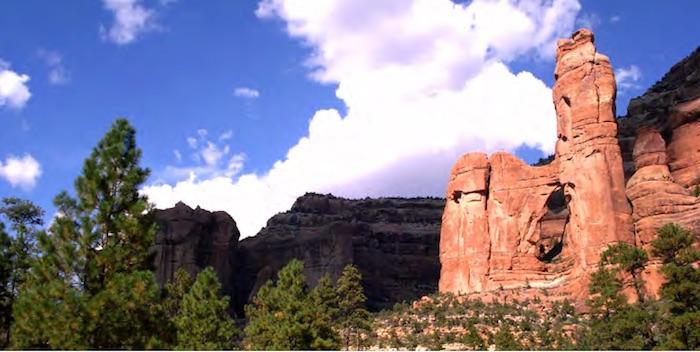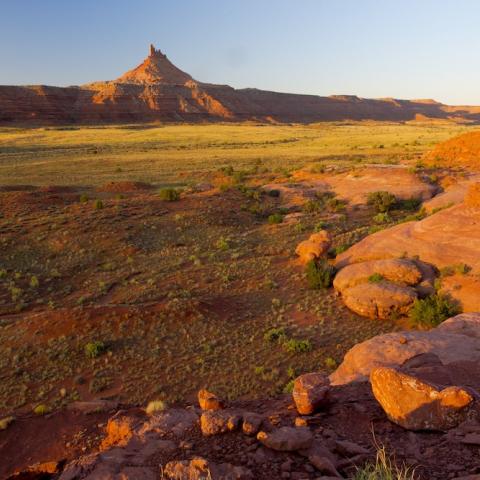
Different legal views on whether President Trump can abolish Bears Ears National Monument are certain to spur lots of debate/U.S. Forest Service
Two legal analyses have been added to the debate over whether President Trump can unilaterally rescind the designation of Bears Ears National Monument in Utah and, not surprisingly, they reach different conclusions.
In stating that the president by himself cannot rescind the designation, five attorneys from the East Coast firm of Arnold & Porter Kaye Scholer LLP held that only Congress has the power to revoke such a designation.
"... as to those national monuments which were made part of the National Park System, Congress has mandated that the power to manage those special places 'shall not be exercised in derogation of the values and purposes for which the System units have been established, except as directly and specifically provided by Congress,'" they wrote in the analysis distributed by U.S. Rep. Raúl Grijalva on Tuesday. "Revoking the designation of such a national monument and pulling it out of the National Park System would certainly be in derogation of the reasons such special places were added to that System. The revocation of the designation of a national monument, and particularly one added to the National Park System, is therefore beyond the power of a president acting alone."
But John Yoo and Todd Gaziano of the American Enterprise Institute counter that they "believe a president’s discretion to change monument boundaries is without limit, but even if that is not so, his power to significantly change monument boundaries is at its height if the original designation was unreasonably large under the facts as they existed then or based on changed circumstances."
Both analyses, attached below, likely will gain wide distribution in the West, where the political ambition to see the Bears Ears designation rescinded is greatest. While Maine Gov. Paul LePage wants President Trump to rescind the designation of Katahdin Woods and Waters National Monument, at least two members of that state's congressional delegation disagree with the governor, saying they're seeing signs that the monument is helping to spur the economy around it.

Congress has claimed the authority to oversee all management of federal lands under the Property Clause of the U.S. Constitution/Patagonia photo of Bears Ears landscape
In their argument, Messieurs Yoo and Gaziano challenge a 1938 opinion from U.S. Attorney General Homer Cummings that said presidents did not have the authority under the Antiquities Act to abolish national monuments, and note that it's never been tested in court.
"We think this opinion is poorly reasoned; misconstrued a prior opinion, which came to the opposite result; and is inconsistent with constitutional, statutory, and case law governing the president’s exercise of analogous grants of power," they wrote. "Based on a more careful legal analysis, we believe that a general discretionary revocation power exists."
The two also raise the possibility that President Obama overstepped his authority in designating national monuments, and so they were created illegally and could be rescinded.
Yoo and Gaziano also posit that it could be difficult to legally challenge a move by President Trump to abolish a national monument.
"Someone would have to establish standing to sue to overturn a later declaration of invalidity or a revocation, and that might be quite difficult in many cases," they wrote in their 26-page paper. "Standing has been a hurdle for many challenging monument designations that impaired grazing, timber, mining, or other rights to use the reserved land. It might be even more difficult for a party to establish a sufficient and particularized injury that resulted from a monument revocation that restores land to public use."
If it was determined that a president could not overturn a monument designation entirely, they added later, surely a president could reduce the size of a monument. To back up that contention, they cite National Park Service records noting that:
- President Eisenhower reduced the reservation for Great Sand Dunes National Monument by 25 percent. (He reduced the original 35,528-acre monument by a net 8,920 acres.)
- President Truman diminished the reservation for Santa Rosa Island National Monument by almost half. (The original 9,500-acre reservation by Franklin Roosevelt was diminished by 4,700 acres.)
- Presidents Taft, Wilson, and Coolidge collectively reduced the reservation for Mount Olympus by almost half, the largest by President Wilson in 1915 (cutting 313,280 acres from the original 639,200-acre monument).
- The largest percentage reduction was by President Taft in 1912 to his own prior reservation in 1909 for Navajo National Monument. (His elimination of 320 acres from the original 360-acre reservation was an 89 percent reduction.)
"One textual command supporting boundary adjustments is that the (Antiquities) act requires reservations to be 'in all cases ... confined to the smallest area compatible with the proper care and management of the objects to be protected,'" they noted. "There is no temporal limit to this requirement, and some presidential proclamations adjusting the boundaries of existing monuments recognize a continuing duty to review and comply with it. Even if boundary adjustments to date had all been somewhat minor, which is not the case, it is hard to read into the text a limiting principle that allows large additions but not large reductions."
In countering those views, the attorneys (Robert Rosenbaum, Andrew Shipe, Lindsey Beckett, Andrew Treaster, and Jamen Tyler) from Arnold & Porter Kaye Scholer note that when the Federal Land Policy and Management Act was adopted in 1976, "the House committee explained that that law 'would also specially reserve to the Congress the authority to modify and revoke withdrawals for national monuments created under the Antiquities Act."
Furthermore, they argue that a president has no authority through either the Constitution or an act of Congress to rise above Congress's authority under the Property Clause, "which provides that '[t]he Congress shall have power to dispose of and make all needful rules and regulations respecting the territory or other property belonging to the United States.'"
The five also noted that when Congress passed FLPMA in 1976, the House report not only stated that Congress would continue to hold the authority to "create, modify, and terminate withdrawals for natioanl parks, national forests, the Wilderness system, ... It would also specially reserve to the Congress the authority to modify and revoke withdrawals for national monuments created under the Antiquities Act."
That authority under Congress was underscored by the fact that national monuments are part of the National Park System, they went on.
"(I)n the 1978 'Redwood Amendment,' Congress mandated that the protection, management, and administration of the System units shall be conducted in light of the high public value and integrity of the System and shall not be exercised in derogation of the values and purposes for which the System units have been established, except as directly and specifically provided by Congress," they wrote.
The Arnold & Porter Kaye Scholer attorneys also noted that as part of its agreement to become part of the United States through grants of land made by the federal government, "the state agreed that it and its people did not have, and would never attempt to claim, title to federal lands other than those that the federal government expressly agreed to give them. Similar provisions were included in the acts creating other western states and in their respective state constitutions."



 Support Essential Coverage of Essential Places
Support Essential Coverage of Essential Places







Comments
The same John Yoo who declared that waterboarding is not torture.